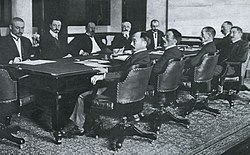Treaty of Portsmouth

The Treaty of Portsmouth formally ended the 1904-1905 Russo-Japanese War. It was signed on September 5, 1905 after negotiations at the Portsmouth Naval Shipyard near Portsmouth, New Hampshire in the United States.
Negotiations
Delegates who signed the peace agreement were Sergius Witte and Roman Rosen for Russia, and Komura Jutaro and Takahira Kogoro for Japan. Fyodor Martens and other diplomats from both nations stayed in New Castle, New Hampshire at the Hotel Wentworth (where the armistice was signed), and were ferried across the Piscataqua River for negotiations held on the base located in Kittery, Maine. The General Stores Building (now Building 86) was used for the meetings. Mahogany furniture patterned after the Cabinet Room of the White House was ordered from Washington. The large conference table is today preserved at the Museum Meiji Mura in Inuyama, Aichi Prefecture, Japan.
In accordance with the treaty, both Japan and Russia agreed to evacuate Manchuria and return its sovereignty to China, but Japan was leased the Liaodong Peninsula (containing Port Arthur and Talien), and the Russian rail system in southern Manchuria with access to strategic resources. Japan also received the southern half of the Island of Sakhalin from Russia. Although Japan gained a great deal from the treaty, it was not nearly as much as the Japanese public had been led to expect, since Japan's initial negotiating position had demanded all of Sakhalin and a monetary indemnity as well.[citation needed] The frustration caused the Hibiya riots, and collapsed Katsura Taro's cabinet on January 7, 1906.
Negotiations for the treaty were taken under the mediation of Theodore Roosevelt, for which he won the 1906 Nobel Peace Prize. Both sides were seeking a peace — the Russians had been repeatedly defeated and the Japanese were in considerable financial difficulties. Negotiations lasted through August. Prior to the beginning of negotiations, the Japanese had signed the Taft-Katsura agreement with the United States in July 1905, agreeing to Japanese control in Korea in return for American dominance in the Philippines. Also, the Japanese agreed with Britain to extend the Anglo-Japanese treaty to cover all of Eastern Asia, in return for Britain also agreeing to Japanese control over Korea. The treaty confirmed Japan's emergence as the pre-eminent power in East Asia, and forced Russia to abandon its expansionist policies there, but it was not well received by the Japanese public.
Centennial
In 2005, a summer-long series of events was held in Portsmouth to mark the 100th anniversary of the signing of the treaty, including a visit by a U.S. Navy destroyer, a parade, and a re-enactment of the arrival of diplomats from the two warring nations. The treaty was signed at 3:47 p.m. on September 5, 1905, marked by an honor guard, the firing of a 19-gun salute and the ringing of area church bells, all of which were duplicated on the same date in 2005. [1], [2]
References
- Geoffrey Jukes, The Russo-Japanese War 1904-1905, Osprey Publishing, Oxford, England 2002
External links
- The Treaty of Portsmouth, 1905, Russo-Japanese War (actual text)
- Portsmouth Peace Treaty, 1905-2005
- The Museum Meiji Mura
This article incorporates text from OpenHistory.



